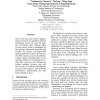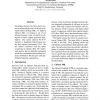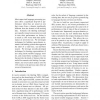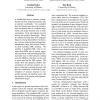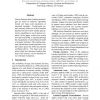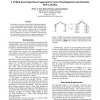COLING
2010
13 years 7 months ago
2010
News tweets that report what is happening have become an important real-time information source. We raise the problem of Semantic Role Labeling (SRL) for news tweets, which is mea...
EMNLP
2009
13 years 10 months ago
2009
Unknown lexical items present a major obstacle to the development of broadcoverage semantic role labeling systems. We address this problem with a semisupervised learning approach ...
ACL
2010
13 years 11 months ago
2010
One deficiency of current shallow parsing based Semantic Role Labeling (SRL) methods is that syntactic chunks are too small to effectively group words. To partially resolve this p...
ACL
2010
13 years 11 months ago
2010
Developing features has been shown crucial to advancing the state-of-the-art in Semantic Role Labeling (SRL). To improve Chinese SRL, we propose a set of additional features, some...
ACL
2010
13 years 11 months ago
2010
Most supervised language processing systems show a significant drop-off in performance when they are tested on text that comes from a domain significantly different from the domai...
ACL
2010
13 years 11 months ago
2010
A fundamental step in sentence comprehension involves assigning semantic roles to sentence constituents. To accomplish this, the listener must parse the sentence, find constituent...
ACL
2010
13 years 11 months ago
2010
Current Semantic Role Labeling technologies are based on inductive algorithms trained over large scale repositories of annotated examples. Frame-based systems currently make use o...
EMNLP
2006
14 years 2 months ago
2006
This paper demonstrates two methods to improve the performance of instancebased learning (IBL) algorithms for the problem of Semantic Role Labeling (SRL). Two IBL algorithms are u...
ACL
2006
14 years 2 months ago
2006
We present a FrameNet-based semantic role labeling system for Swedish text. As training data for the system, we used an annotated corpus that we produced by transferring FrameNet ...
AAAI
2006
14 years 2 months ago
2006
In this paper, we present a unified knowledge based approach for sense disambiguation and semantic role labeling. Our approach performs both tasks through a single algorithm that ...
